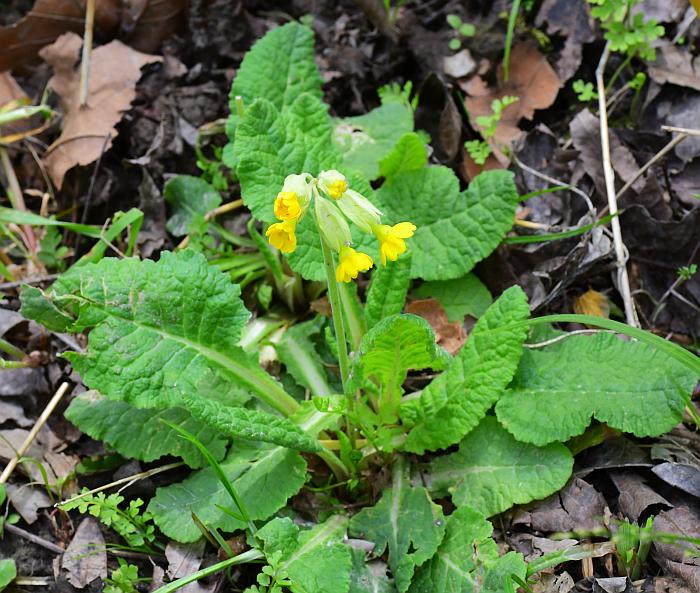Primula veris L.
English Cowslip

Introduced
CC = *
CW = 5
MOC = 2
© SRTurner
Primula veris L.English Cowslip | |
 |
Introduced CC = * CW = 5 MOC = 2 |
© SRTurner |
|
Family - Primulaceae Habit - Rhizomatous perennial forb. Stem - Aerial stems absent. Leaves - Basal, in a dense rosette. Basal leaves 3-20 cm long, the blades ovate, oblong-ovate, or oblong-obovate, abruptly tapered at the base to a well-defined, winged petiole 2-9 cm long, rounded to a blunt point at the tip, the margins somewhat curled-under and/or somewhat corrugated, also with shallow, broad teeth or scallops, the upper surface sparsely to moderately pubescent with a mixture of short, stiff, unicellular hairs and more flexible multicellular hairs, slightly roughened to the touch, often slightly shiny, the undersurface moderately to densely pubescent with short, grayish white, multicellular hairs, especially along the main veins, pale green, sometimes with reddish coloration toward the base, especially along the broad midvein, the venation prominently expressed.
Inflorescences - Umbels with 3-15 flowers, the involucral bracts 4-9 mm long, narrowly lanceolate, the flower stalks 0.5-2.0 cm long, densely and minutely grayish white-hairy. Peduncle scapes 12-35 cm tall, densely pubescent with short, grayish white hairs.
Flowers - Calyces 8-15 mm long, lobed about 1/3 of the length. Corollas with the tube 9-15 mm long, yellow or orange at the throat, the lobes 5-14 mm long, 4-7 mm wide, spreading or loosely ascending, conspicuously notched at the tip, usually yellow, often with an orange to reddish spot on the upper surface at the base. Stamens not exserted, the filaments individually fused nearly their entire length to the inner surface of the corolla tube, the anthers 1.5-2.5 mm long, free, positioned either near the corolla throat (in short-styled plants) or toward the midpoint of the corolla tube (in long-styled plants). Style variously 4-15 mm long (in shortor long-styled flowers), slender, the stigma relatively conspicuous, capitate.
Fruits - Capsules 4-8 mm long, 3-5 mm wide, thick-and hard-walled, dark brown. Seeds 0.6-1.0 mm long, oblong-ellipsoid to more or less cuboid, mostly relatively angular, reddish brown. Flowering - April - June. Habitat - Forest edges, roadsides. Also cultivated. Origin - Europe. Lookalikes - None. Other info. - This is a very rare species in Missouri. Thus far it has been collected from only a single site in the state, representing a population persisting and well naturalized from an old cultivation of many years ago. Truly wild populations are unknown in the state. Other occurrences in the continental U.S. are restricted to the northeast, and also usually represent persistence from former cultivation or, infrequently, escapes. The plant is easily recognized from its basal rosette of rugose leaves, and leafless scapes of distinctive yellow flowers. It is quite attractive and, apparently, not at all aggressive in our area. Photographs taken at Shaw Nature Reserve, Franklin County, MO, 4-8-2007, 4-27-2021, and 4-25-2025 (SRTurner). |